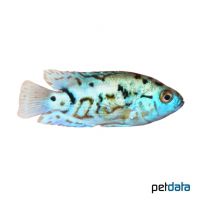Electric Blue Dempsey (Rocio octofasciata 'Blue Dempsey')
| Electric Blue Dempsey Rocio octofasciata 'Blue Dempsey' | |
|---|---|
| Name | Electric Blue Dempsey |
| Name Lat. | Rocio octofasciata 'Blue Dempsey' |
| Synonym | Electric Blue Jack Dempsey |
| Family | Cichlids |
| Family lat. | Cichlidae |
| Order | Cichlids |
| Order lat. | Cichliformes |
| Origin | Central America (breeding variety) |
| Habitat | Aquarium |
| Diet | Omnivore |
| pH | 6.5-8.0 |
| Behavior | Aggressive |
| Keeping | Pair |
| Care Level | Moderate |
| Reproduction | Substrate spawner |
| Breeding | Simple |
| Life Span | 10-12 years |
| Protection | No |
| Metric Units | |
| Size | 15-20 cm |
| Temperature | 20-30 °C |
| Hardness | 5-20 °dH |
| Aquarium | ~ 350 l |
| US Units | |
| Size | 6"-8" |
| Temperature | 68-86 °F |
| Hardness | 89-356 ppm |
| Aquarium | ~ 90 gal |
Distribution and habitat
The blue eight banded cichlid is a breeding form. The wild form originates from the Atlantic side of Central America, where it occurs from southern Mexico through Belize and Guatemala to Honduras. They live in the coastal lower reaches of rivers, where they are mostly found in still water, as well as in lakes, drainage canals, and ponds with soft mud and sand bottoms
Maintenance
They require a well-structured aquarium with robust perimeter planting, branches and roots that provide hiding places and some shallow river pebbles (spawning areas), as well as free swimming space. A soft, sandy substrate for burrowing and subdued light (floating plant cover) is ideal.
No ammonia, ammonium and nitrite should be detectable, the nitrate value should not exceed 100 mg/l. To ensure the water quality and oxygen content, a filter and heater adapted to the aquarium size is required, as well as lighting for the species-appropriate day-night rhythm of the animals.
Diet
The food supply consists of live or frozen daphnia, artemia, mysis, tubifex, red mosquito larvae, etc., supplemented with some vegetable food (vegetables, spirulina) and commercially available frozen special food mixtures. Also high quality sinking dry food (pellets, chips, granules) for cichlids is accepted without problems. Only as much should be fed as is eaten within a few minutes. A regular and varied diet promotes health and increases resistance.
Behaviour and compatibility
They should be kept in pairs. Especially during the spawning season, they strongly defend their territory against conspecifics and other fish with similar appearance. Several pairs can only be kept together in a much larger and richly structured aquarium. Socialization with fish of similar size is well possible. Fish that are too small are considered prey. Basically, only compatible fish species with similar demands on water condition and water temperature may be socialized.
Sex dimorphism
Males are more strongly colored and have a longer and more pointed dorsal and anal fin. With some experience, the sexes can be distinguished by their genital papilla, which is pointed in the male and ends flat in the female.
Reproduction and breeding
For successful breeding of Blue Dempseys they have to be backcrossed with normal eight-banded cichlids, obtaining about 25% Blue Dempseys from one clutch. They spawn on shallow rocks or roots (open brooders). Both parents perform brood care and defend the territory (parent family). After about 2 days, the fry hatch and are then usually housed in a bottom pit until they swim freely after 5-7 days. Often the fry are still guarded by the parents for some time and are led to the feeding places in the aquarium.
Fry must be fed several times a day with special rearing food (Artemia). Breeding is hardly possible in community tanks, where the fry are easy prey.
Important
The intense blue coloration of the young decreases with age.
They like to burrow and often damage plants in the process. With sufficient feeding with plant food, the aquarium plants are spared.
The well-being of the fish should be checked regularly. Temperature should be checked daily, pH, hardness and nitrate levels should be checked at least every 14 days. Regular partial water changes are recommended, even if the pollutant level has not yet reached the upper limit. Sudden changes in water quality should be avoided. Newly introduced fish must be accustomed slowly to the water in the aquarium.
Further literature can be found in your pet store.
References
Text: petdata; Image: petdata
Source: BMEL (1998): Tierschutzgutachten - Haltung von Zierfischen (Süßwasser); RIEHL & BAENSCH (2006): Aquarien Atlas Bd. 1, Mergus Verlag; ENGELMANN (2005): Zootierhaltung - Tiere in menschlicher Obhut: Fische, Verlag Harri Deutsch
- Gemäß § 21 Abs. 5 Tierschutzgesetz idgF
